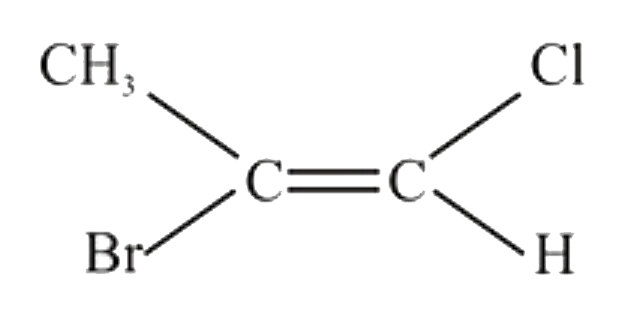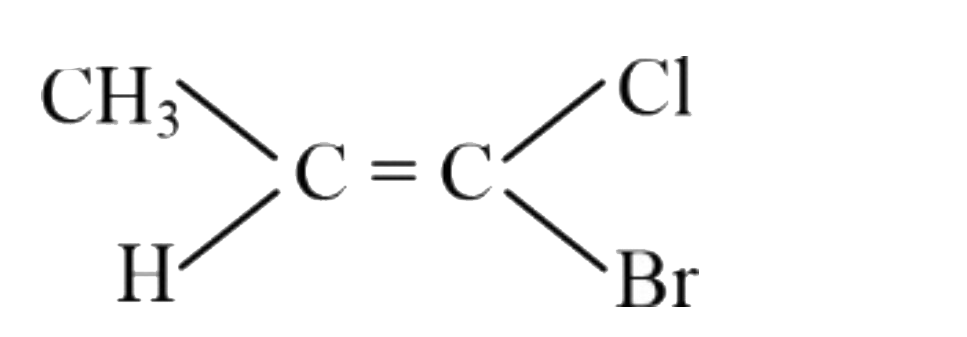Which one of the following is an Z isomer ?




The correct Answer is:A
To determine which of the given compounds is a Z isomer, we need to follow these steps:
Step 1: Understand Z and E Isomerism
Z isomers occur when the highest priority substituents on each carbon of a double bond are on the same side. E isomers occur when the highest priority substituents are on opposite sides.
Step 2: Assign Priority to Substituents
To assign priority, we use the Cahn-Ingold-Prelog priority rules, which state that the atom with the higher atomic number gets higher priority.
Step 3: Analyze Each Option
1. Option 1:
- Substituents: CH3 and H on one carbon; Br and Cl on the other.
- Priority:
- For the first carbon: CH3 (C) > H.
- For the second carbon: Br > Cl.
- Both high priority groups (Br and CH3) are on the same side → Z isomer.
2. Option 2:
- Substituents: CH3 and H on one carbon; Br and Cl on the other.
- Priority:
- For the first carbon: CH3 (C) > H.
- For the second carbon: Br > Cl.
- High priority groups (Br and CH3) are on opposite sides → E isomer.
3. Option 3:
- Substituents: CH3 and H on one carbon; Br and Cl on the other.
- Priority:
- For the first carbon: Br > CH3.
- For the second carbon: Cl > H.
- High priority groups (Br and Cl) are on opposite sides → E isomer.
4. Option 4:
- Substituents: CH3 and H on one carbon; CH3 and H on the other.
- Priority:
- Both carbons have the same substituents (C > H).
- High priority groups are on opposite sides → E isomer.
Conclusion
The only option that is a Z isomer is Option 1.
---
Z isomers occur when the highest priority substituents on each carbon of a double bond are on the same side. E isomers occur when the highest priority substituents are on opposite sides.
To assign priority, we use the Cahn-Ingold-Prelog priority rules, which state that the atom with the higher atomic number gets higher priority.
1. Option 1:
- Substituents: CH3 and H on one carbon; Br and Cl on the other.
- Priority:
- For the first carbon: CH3 (C) > H.
- For the second carbon: Br > Cl.
- Both high priority groups (Br and CH3) are on the same side → Z isomer.
- Substituents: CH3 and H on one carbon; Br and Cl on the other.
- Priority:
- For the first carbon: CH3 (C) > H.
- For the second carbon: Br > Cl.
- High priority groups (Br and CH3) are on opposite sides → E isomer.
- Substituents: CH3 and H on one carbon; Br and Cl on the other.
- Priority:
- For the first carbon: Br > CH3.
- For the second carbon: Cl > H.
- High priority groups (Br and Cl) are on opposite sides → E isomer.
- Substituents: CH3 and H on one carbon; CH3 and H on the other.
- Priority:
- Both carbons have the same substituents (C > H).
- High priority groups are on opposite sides → E isomer.
The only option that is a Z isomer is Option 1.
Topper's Solved these Questions
Similar Questions
Knowledge Check
Which one of the following is a Z isomer ?
A B
B C
C D
D
Which one of the following is not an isomer of 3-methylbut-1-yne?
APent-1-yneBButa-1, 3-dieneCPent-2-yneDPenta-1, 3-dieneWhich one the following is an Z isomer ?
A B
B C
C D
D
Which one of the following is not an isomer of 3-methylbut-1-yne?
View SolutionWhich of the following is an E isomer ?
View SolutionWhich one of the following pairs of isomers and types of isomerism are CORRECTLY matched ?
View SolutionWhich of the following is not an isomer of cyclopropanol?
View SolutionWhich of the following is NOT an isomer of hexane ?
View Solution
